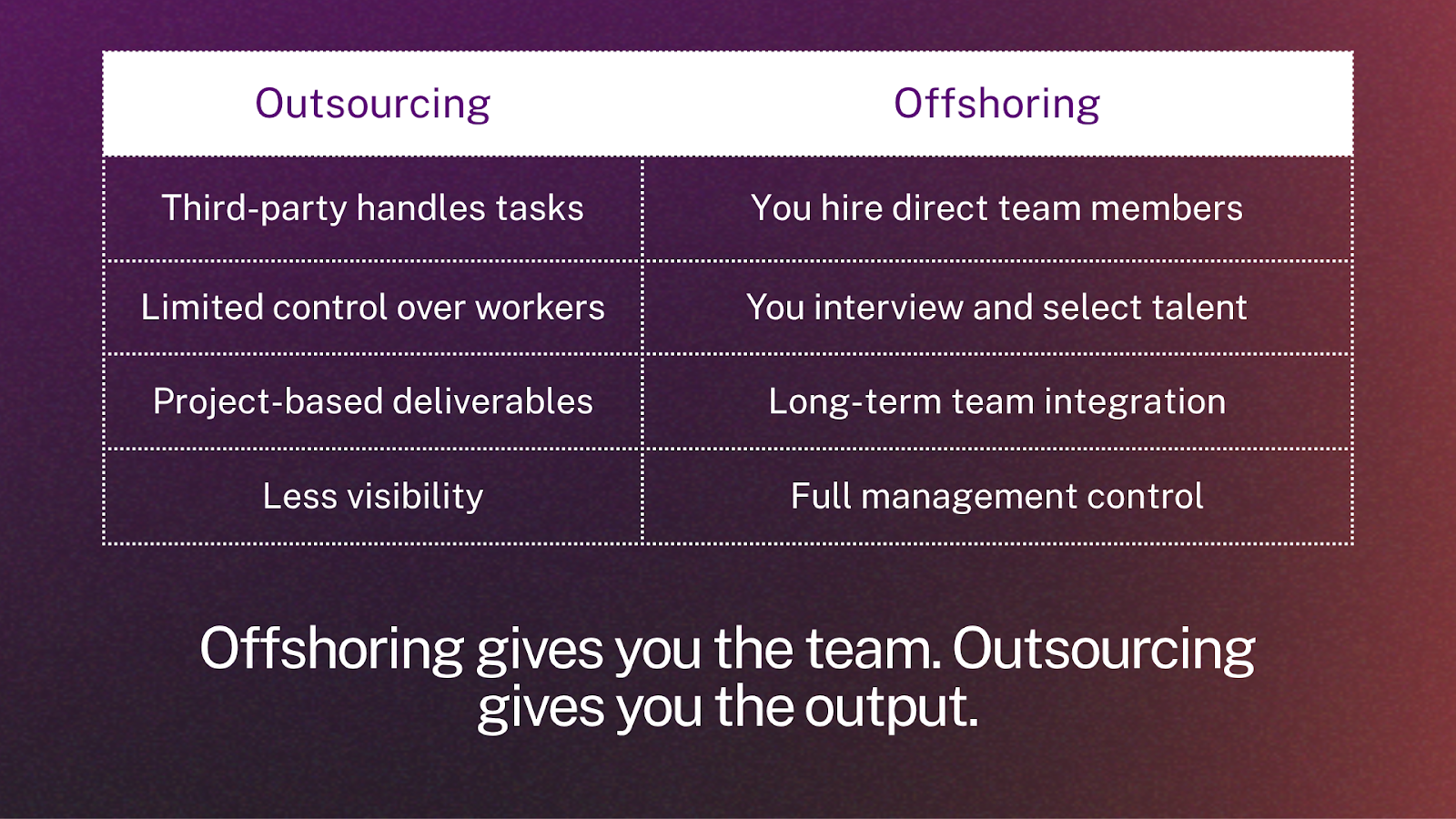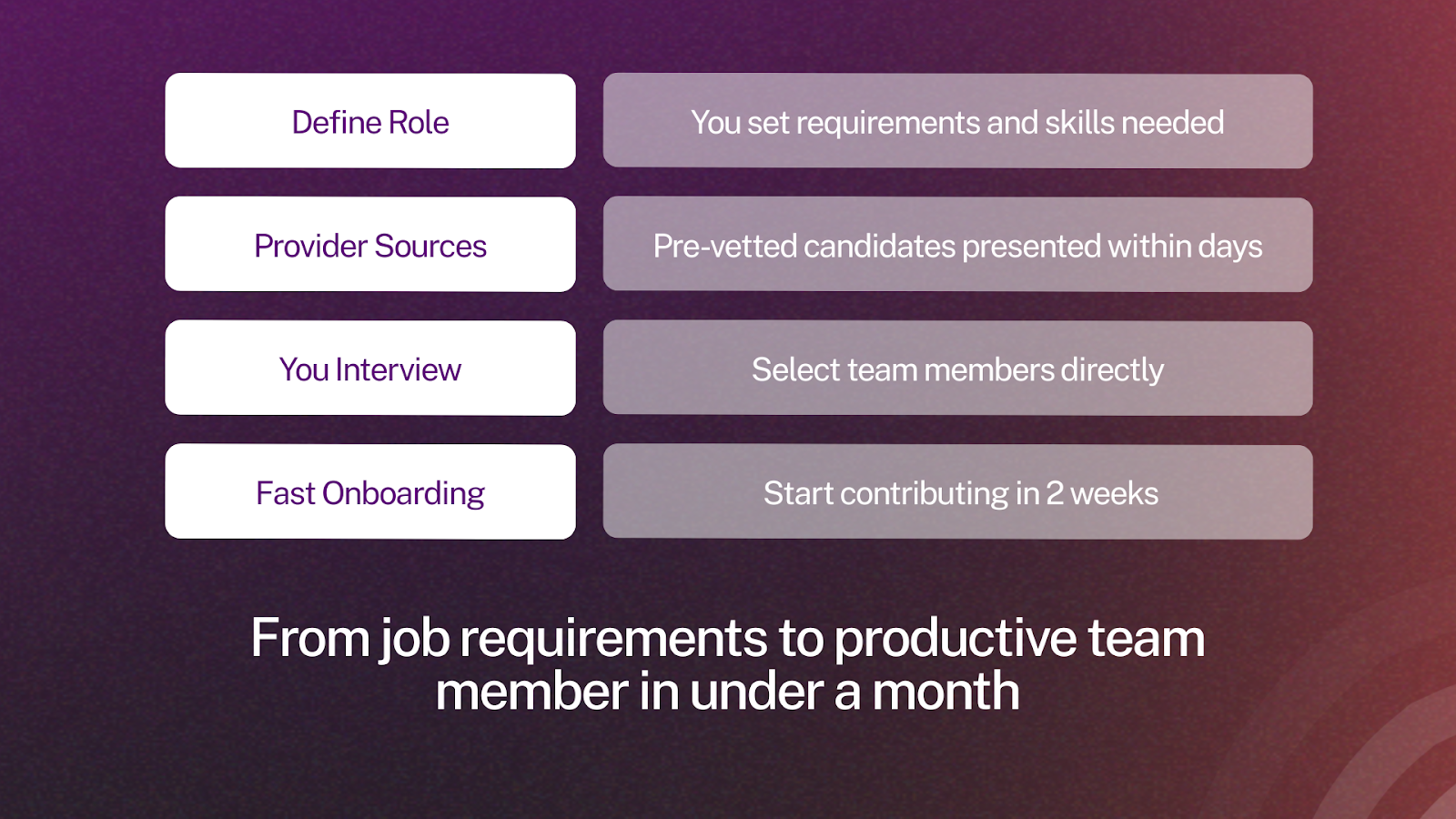Hiring in the U.S. takes time and money. A mid-level designer costs $50,000 to $82,000 per year. A project manager runs $80,000 to $138,000. Add benefits, taxes, and recruitment fees, and the actual cost climbs higher.
That’s why more teams are hiring offshore talent, especially from Latin America (LATAM). You get skilled professionals who work in similar time zones, communicate well, and integrate easily with your existing team - often at half the cost.
Let’s break down why offshoring makes sense in 2025, what kind of savings you can expect, and how to build offshore teams that actually work for you.
What Is Offshore Talent?
Offshore talent refers to professionals hired from other countries - often in regions like LATAM - to help businesses lower costs, access specialized skills, and scale global operations efficiently.
These hires work as part of your team. They attend your meetings, use your tools, and report to your managers. The difference is location and cost, not quality or commitment.
Offshoring vs. Outsourcing

Outsourcing means handing off work to a third party. You get deliverables, but you don't manage the people doing the work.
Offshoring means hiring actual employees or contractors who work for you directly. You interview them, choose them, and manage their work. They integrate with your existing team and contribute to long-term goals.
The main difference is control. With outsourcing, you have limited say in who does the work. With offshoring, you build a team.
How Businesses Scale Faster with Offshore Teams?
Local hiring takes four weeks or more. Offshore providers with established pipelines can vet candidates within days and complete onboarding in two weeks.
This speed matters when you need to launch a campaign, expand a product line, or handle seasonal demand.
Instead of waiting for the right local candidate, you can move forward with qualified professionals who start contributing immediately.
Why Offshore Talent Matters Today
Remote work over the past few years showed that teams don’t need to share an office to perform well. What matters most are skills, communication, and consistency.
Offshore hiring builds on that idea. It lets you hire skilled professionals in regions with strong talent and lower costs.
Hiring offshore helps grow without the full cost of local hires and makes it easier to test projects, reach new markets, and scale quickly.
Top Reasons to Hire Offshore Talent
Cost Savings and Efficiency Gains
Salaries in LATAM are significantly lower than U.S. equivalents. A graphic designer in Colombia earns an average $6,600 per year. In the U.S., the same role costs $50,000 to $82,000.
Here's how costs compare across common roles:
Sources: Glassdoor, Payscale 20252025
These savings let you hire two or three professionals for the cost of one local hire. That means more capacity without increasing your budget.
Access to Global Specialized Expertise
Some roles are hard to fill locally. Finding a senior UX designer, bilingual copywriter, or skilled video editor in the U.S. can take months.
LATAM offers strong talent in creative and marketing fields. Mexico best in digital marketing, Colombia in design and project management, Brazil in content creation, and Argentina in campaign strategy. Many professionals already work with U.S. clients and understand how American businesses operate.
Flexible, Scalable Teams
Offshore hiring lets you scale up or down as demand shifts. You can add people for a launch or campaign, then adjust once the project ends.
This flexibility helps with seasonal work, pilot programs, or testing new services without the commitment of full-time local hires.
24/7 Operations with a Follow-the-Sun Model
LATAM teams work close to U.S. hours, giving you extended coverage without overnight shifts. A designer in Colombia can finish projects after your local team signs off, keeping work moving.
For customer support, splitting coverage between regions extends service hours and reduces burnout. It’s a simple way to maintain quality across time zones.
How Companies Use Offshore Talent to Scale?

Companies partner with firms like Floowi to connect with vetted professionals across LATAM and grow faster without the overhead of traditional hiring.
It starts with a clear role definition. Once requirements are set, the provider sources and screens candidates, then shares a shortlist of qualified options. You handle the interviews and make the final choice.
From there, the provider manages contracts, payroll, and compliance - eliminating the need to open entities in multiple countries. This structure keeps hiring simple, compliant, and scalable.
Common Challenges When Hiring Offshore Talent
Hiring offshore talent comes with challenges, but most are easy to manage with structure and communication.
Cultural and Communication Gaps
Cultural differences exist, but LATAM professionals already understand U.S. work culture and expectations.
The key solution is clarity - define how you communicate, which tools you use, and expected response times. Regular check-ins help prevent small issues from growing.
Time Zone Management and Coordination
LATAM teams work within 0 to 3 hours of U.S. time zones. This overlap makes real-time collaboration easy compared to hiring from Asia (10-13 hour difference) or Eastern Europe (6-9 hour difference).
Set clear overlap hours for meetings, and use async tools like Slack, Loom, or Asana for updates and task tracking.
Quality Control
Quality concerns aren’t unique to offshore hiring, they apply to every hire.
The solution is structure: use vetted providers, request work samples, set measurable goals, and review output early. Once trust builds, oversight becomes easier.
Legal and Compliance Risks
Every country has different employment laws. Misclassifying contractors or skipping local compliance can lead to fines. The safest route is using an Employer of Record (EOR) that manages contracts, payroll, and taxes on your behalf.
Challenge vs. Solution
How to Hire and Manage Offshore Teams Successfully
Hiring offshore works best with a clear plan for finding, onboarding, and managing your team.
Where to Find Reliable Talent
Start with providers that specialize in your target region. For LATAM, focus on Mexico, Colombia, Brazil, and Argentina.
Ask about their vetting process, time to hire, retention rates, and whether they handle compliance and payroll. A good provider makes offshore hiring feel like local hiring, just more cost-effective.
Integration and Onboarding
Treat offshore hires like any other employee. Give them access to tools, introduce them to the team, and explain workflows.
Set clear expectations for communication, deadlines, and performance, and assign a point person for questions. The faster they feel integrated, the sooner they contribute.
Communication Strategies
Use consistent tools across the team - Slack, Zoom, Asana, and keep documentation clear.
Schedule regular one-on-ones to review progress, provide feedback, and address concerns. Clear, consistent communication builds trust and alignment.
Maintaining Company Culture
Include offshore employees in meetings, updates, and celebrations. Culture isn’t about location, it’s about how decisions are made, how teams collaborate, and how achievements are recognized.
Offshore hires can fully embody your company culture when included intentionally.
Tracking Performance and Retention
Set measurable goals and review them regularly. Apply the same standards as local hires.
Monitor retention rates - high turnover signals issues in hiring, onboarding, or management. When treated well and given growth opportunities, offshore hires often stay for years.
Best Countries to Hire Offshore Talent in 2025
Latin America: Nearshore Collaboration and Creative Roles
LATAM is a top choice for U.S. companies. Time zones overlap, English proficiency is high, and cultural alignment makes collaboration smooth. Mexico, Colombia, Brazil, and Argentina offer strong talent in creative, marketing, and project management roles.
Professionals understand U.S. business practices, so onboarding is faster and friction is lower.
The Philippines: Customer Support and Virtual Assistants
The Philippines has a large pool of skilled customer support and virtual assistant talent. English proficiency is strong, and costs are low.
The main limitation is time zones; a 12-13 hour difference limits real-time collaboration, making it better suited for support rather than strategic or creative work.
South Africa: English-Proficient, Adaptable Workforce
South Africa offers a professional workforce with strong English skills. Time zones (6-8 hours from U.S. Eastern) allow partial overlap.
It works well for content, support, and admin roles but is less ideal for projects requiring constant, real-time communication.
Why LATAM Works Best for U.S. Companies
Here's how regions compare for U.S. companies:
LATAM combines lower costs with strong skills and easy collaboration. Time zone overlap allows real-time interaction, keeping projects moving and reducing delays.
Is Offshore Hiring Right for Your Business?
Offshore hiring is a strong option when you need to scale quickly, lower costs, or access skills that are hard to find locally.
It works well for creative work, support, and specialized roles. Time zone alignment matters if your work requires real-time collaboration.
Businesses that benefit most include marketing agencies, e-commerce companies, SaaS startups, and creative studios. Remote-first teams adapt fastest since systems for distributed work are already in place.
Ask yourself:
- Can this role be done remotely?
- Do we have clear processes and documentation?
- Are we comfortable managing across time zones?
- Do we have budget for onboarding and tools?
If most answers are yes, offshore hiring can deliver you the best results.
Your Next Move
Offshore hiring isn’t just about saving money, it’s a long-term way to build flexible teams that support growth. You can scale faster, test ideas with less risk, and invest in growth while keeping costs in check.
Integrate offshore hires into your culture, set clear goals, and recognize their work. When they feel valued, they stay longer and perform better.
Ready to scale? Learn why hiring offshore talent through Floowi is the fastest way to build your remote team.
Frequently Asked Questions
When Is the Right Time to Start Hiring Offshore Talent?
Start when you need to scale but don't want to increase costs proportionally. This often happens during growth phases, product launches, or when local hiring becomes too slow or expensive.
What Business Problems Does Offshore Talent Solve?
Offshore talent solves cost constraints, talent shortages, slow hiring timelines, and limited capacity. It lets you expand without the full expense of local hires.
What Job Roles Are Best Suited for Offshore Hiring?
Design, content creation, video editing, customer support, project management, digital marketing, and software development work well offshore. Any role that can be done remotely is a candidate for offshore hiring.
How Much Money Can I Actually Save by Hiring Offshore Talent?
Savings range from 50% to 90% depending on the role and region. A marketing specialist costs $59,000 to $98,000 in the U.S. but around $16,500 in LATAM - a savings of 72% to 83%.
What’s the Typical ROI Timeline for Offshore Talent Investments?
Most companies see ROI within three to six months. Initial costs include recruitment, onboarding, and training, but ongoing savings from lower salaries create positive ROI quickly.
How Do I Maintain Productivity With Offshore Workers?
Set clear goals, use project management tools, and maintain regular communication. Productivity depends more on management and expectations than location.
How Does Offshore Talent Support Business Growth and Scaling?
Offshore talent gives you the capacity to take on more work, launch new projects, and expand into new markets without proportional cost increases. This creates runway for growth.
What Legal Considerations Should I Know Before Hiring Offshore?
Each country has different labor laws, tax requirements, and employment regulations. Work with an Employer of Record to handle compliance and avoid legal issues.










.png)

.png)
